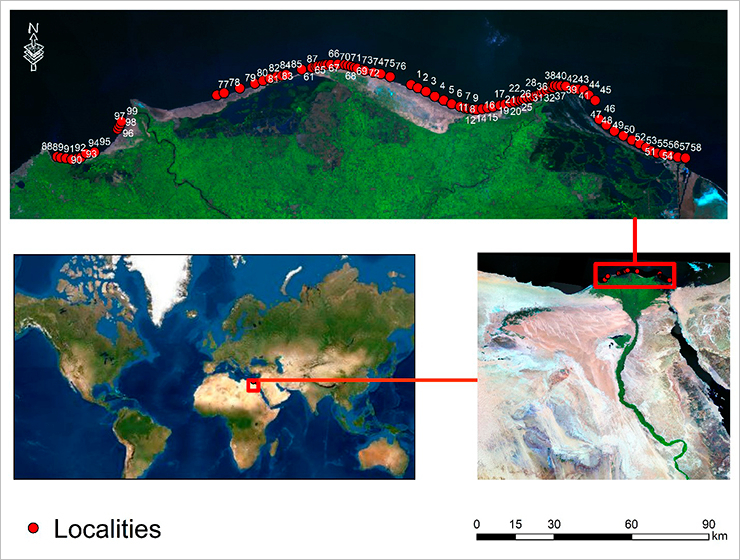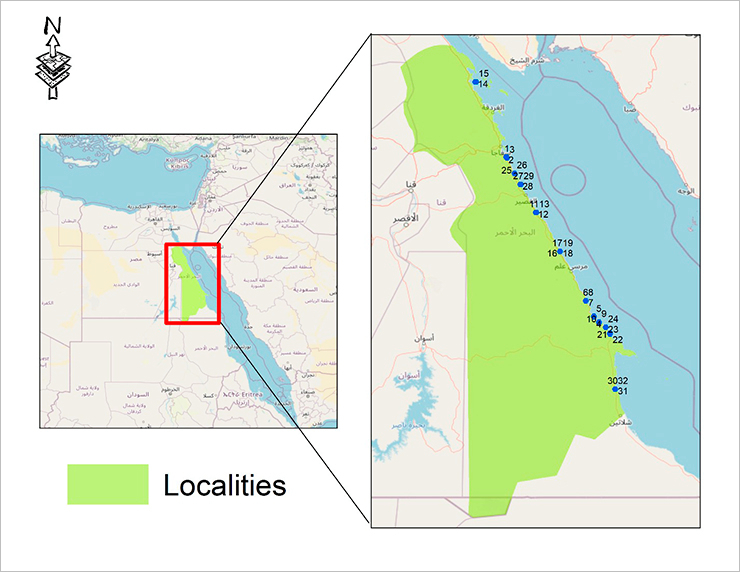JINR scientists assessed environmental situation in coastal waters of Egypt
Media, 12 September 2023
A group of scientists from the Frank Laboratory of Neutron Physics at JINR, in cooperation with their colleagues from Egypt, studied the elemental composition of unconsolidated bottom sediments of the Egyptian coastal waters of the Mediterranean and Red Seas. For this purpose, they studied the collected samples using the neutron activation analysis (NAA) method at the IBR-2 Reactor at JINR, as well as at an inductively coupled plasma mass spectrometer (ICP-MS). As a result, the scientists identified a number of areas with excessive concentrations of various elements. The researchers succeeded in relating these data to the existence of developed industries, intensive shipping traffic, and fishery in these areas. In general, as they note, the Egyptian coasts of the Mediterranean and Red Seas appeared to be quite clean.
The study of these territories became the second stage of a large joint project to assess the environmental situation in Egypt, which started back in 2011. At that time, the FLNP scientists proposed to their Egyptian colleagues to use the unique NAA method to study the elemental composition of samples from the valley of the River Nile, the largest source of clean drinking water on the arid continent. The results of the study, which was carried out until 2018, did not show a critical excess of the concentration of heavy metals in the bottom sediments of the Nile. The river turned out to be cleaner than other reservoirs, the condition of which the group of scientists had already studied. The participants of the study noted only a few particularly polluted places, for example, at the mouth of the river and in the area of the city of Helwan, and related this, among other things, to human activity.
Later, at the next stage of the study, from 2018 to 2021, the focus of attention of the researchers shifted to the coastal areas of the Mediterranean and Red Seas in Egypt, since marine pollution is also a global environmental problem.
 Sample collection sites on the Mediterranean coas
Sample collection sites on the Mediterranean coas
A total of 131 samples were collected from the bottom, namely 99 samples from the Egyptian coastal areas of the Mediterranean Sea and 32 samples from the northern Egyptian sector of the Red Sea. After collection, the samples were cleaned on site, transported to laboratories in Cairo for preliminary treatment and finally sent to FLNP JINR.
The marine sediments were studied using NAA at the IBR-2 Research Reactor at JINR. The scientists determined mass fractions of 43 major and trace elements and 39 oxides in samples from the coasts of the Mediterranean and Red Seas, respectively.
 Sample collection sites on Red Sea coast
Sample collection sites on Red Sea coast
“We have found out that there are places with a high content of metal pollutants – copper, nickel, arsenic, zinc, lead, chromium, and others,” a senior researcher at the FLNP Neutron Activation Analysis Group at JINR, Head of the Egyptian national group at JINR Wael Badawy said. “In the area of the Egyptian Mediterranean coast, these are the coastal area along Manzala Lake and its western coastal area at the mouth of Burullus Lake, as well as the Nile River estuary at Ras Elbar, and the Abu Qir Bay. And in the Red Sea region, two areas, namely Sharm El-Bahari, located in the middle of the coast, and the location below, to the southern part of Marsa Humira, showed peak values.”
To assess the environmental situation, various pollution indices were calculated, including, for example, the enrichment factor, the geoaccumulation index, the pollution load index, the modified pollution index, and environmental risk assessment.
“Although metals occur naturally in marine sediments, it is important to differentiate between background concentrations and pollution caused by anthropogenic sources. In areas where we observed excess metal concentrations, the main pollutants were most likely municipal waste discharges, phosphate mining, and transportation, oil extraction, as well as fishery and shipping traffic. In other places, the concentration of metals was within normal limits, but regular monitoring would be advisable to confirm their good environmental status,” Wael Badawy noted.
The team of JINR researchers and their Egyptian colleagues have already outlined the next objects for research. In the near future, they plan to study air pollution in Egypt, the state of corals and mangroves. In addition, the researchers are searching for new approaches and possibilities in studying the environmental situation.
List of publications:
- W. Badawy, A. Elsenbawy, A. Dmitriev, H. El Samman, A. Shcheglov, A. El-Gamal, N. H. M. Kamel, M. Mekewi. Characterization of major and trace elements in coastal sediments along the Egyptian Mediterranean sea. Marine Pollution Bulletin. 177 (2022) — 113526. https://doi.org/10.1016/j.marpolbul.2022.113526
- A. El-Taher, W. M. Badawy, A. E. M. Khater, H. A. Madkour. Distribution patterns of natural radionuclides and rare earth elements in marine sediments from the Red sea, Egypt. Appl Radiat Isot. 151 (2019) — 171-181. 10.1016/j.apradiso.2019.06.001
- W. M. Badawy, A. El-Taher, M. V. Frontasyeva, H. A. Madkour, A. E. M. Khater. Assessment of anthropogenic and geogenic impacts on marine sediments along the coastal areas of Egyptian Red sea. Appl Radiat Isot. 140 (2018) — 314-326. 10.1016/j.apradiso.2018.07.034